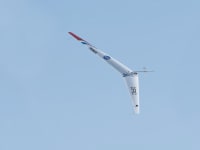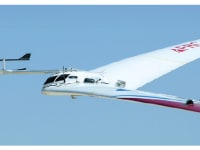

The Problem:
Conventional aircraft make use of elliptical wings to minimize drag. However, achieving
aircraft stability and control in conventional elliptical wings requires a strong adverse
yaw component in roll control (i.e., the aircraft will yaw the opposite direction with
application of roll control). Therefore, a vertical tail or some other method of direct yaw
control is required, such as split elevons for use as drag rudders. The use of elliptical
wings also results in a suboptimal amount of structure to carry the wing root bending
moments. To counteract these problems, engineers at NASA Armstrong Flight Research Center developed an innovative wing design that has proverse yaw to optimize aircraft efficiency.
A Novel Solution and How It Works:
This new patent-pending wing design removes adverse yaw and dramatically increases aircraft efficiency by reducing drag. It optimizes the overall aircraft configuration by reducing the size of—or even removing entirely—the vertical tail and by reducing structural weight.
The researchers designed and validated a scale model of a non-elliptical wing that reduces drag and increases efficiency. Known as the PRANDTL-D (for Preliminary Research Aerodynamic Design to Lower Drag), this wing design addresses integrated bending moments and lift to achieve a 12 percent drag reduction. The approach to handling adverse yaw employs fine wing adjustments rather than the aircraft's vertical tail.
The key to the innovation use of a bell-shaped spanload rather than the conventional elliptical spanload. To achieve the bell spanload, designers used a twisted and sharply tapered wing, with 11 percent less wing area than the comparable elliptical spanload wing. The new wing has 22 percent more span and 11 percent less area, resulting in an immediate 12.5 percent efficiency gain.
Furthermore, using twist to achieve the bell spanload produces induced thrust at the wing tips. This forward thrust increases when lift is increased at the wingtips for roll control. The result is that the aircraft rolls and yaws in the same direction as a turn, eliminating the need for a vertical tail to provide yawing moment. When combined with a blended-wing body, this approach maximizes aerodynamic performance, minimizes weight, and optimizes flight control.
Benefits:
This innovative wing design can significantly increase total aircraft efficiency:
-- Highly efficient: Reduces adverse yaw when correcting for roll
-- Economical: Improves fuel efficiency by allowing aircraft to fly faster
-- Safer: Reduces adverse yaw when correcting for roll
-- Simpler: Requires no vertical stabilizers, easing production
Applications:
This technology is ideal of mid-sized commercial aircraft; drones or UAVs (unmanned aerial vehicles), wind turbines and fans, and energy delivery systems.
Market Potential:
This technology’s commercial potential is strong thanks to its drag reduction and overall performance increases for aeronautics and aerospace applications. In addition, the wind energy industry is open to new bladed designs that improve efficiency, and this market segment is large and growing. Discussions are underway with a market leader in the manufacturing of wind turbines.
Video
-
Awards
-
 2016 Aerospace & Defense Honorable Mention
2016 Aerospace & Defense Honorable Mention -
 2016 Top 100 Entries
2016 Top 100 Entries
Like this entry?
-
About the Entrant
- Name:Al Bowers
- Type of entry:teamTeam members:Albion (Al) Bowers, NASA Armstrong Flight Research Center Peter Uden, professor
- Patent status:pending








